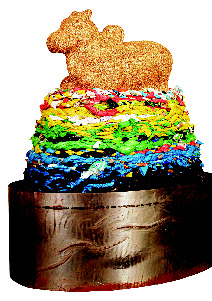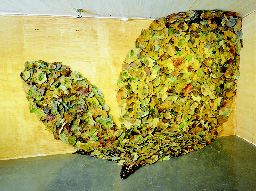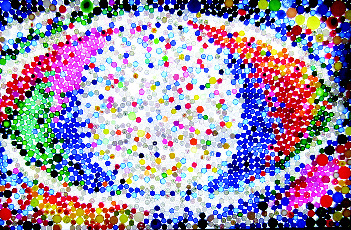In the realm of Contemporary Art, the Naive should not be a synonym for either ignorance or immaturity. Neither should a Purist approach adhering to painterly principles, be misprepresented as an ‘immature idiom that lacks cutting-edge’. Pure painterly skill remains the highest point in artistic achievement --- it is a talent that no mechanical gimmickry or distractions can ever replace or outdo.
In the past decade, however, a certain rapid influx of ‘cool, trendy urban aesthetic experimentation’ has been increasingly doing the rounds in Indian gallery circuits. This ‘Aesthetic Re-Colonisation’ has found a footing in India. These ‘art-formulae’ are evidently motivated by a pursuit of quick and convenient ‘international exposure’. Such facile experimentations -- which now border on western gallery-cliches -- are actively diluting the authentic quality of Indian Art’s contemporaneity, thus robbing our art of both its painterly skills and its emotional credibility.
This alarming ‘International Art-Factory’ approach can only be countered with a firm adherence to one’s cultural ethos, and by the application of the intricacy of our own deep-rooted, traditional aesthetic principles.These time-tested artistic tenets contain the depth and real seeds of ‘Modernism’.


This is precisely the dilemma that Gurgaon-based artist Arun Kumar’s experimentations seem to exemplify. The 44-year old is from a small village in the Western Ghats of Karnataka. He hails from a farmer’s family, and harsh forests were the very backyard of his father’s home. Arun apprenticed as a traditional wood-carver, to support his initial art-training at the local Davangere Art School. This was followed by art courses in Baroda, and then a fellowship at Delhi’s Garhi Studios, making him a city-artist.
When asked what was his breakthrough into the current art world, Arun says -- “In 1999, I attended the ARCUS Artists’ Program in Ibaraki near Tokyo, with artists from USA, France and Japan. This was my major opportunity, that gave me all kinds of support to make my inflatable sculptures, and exhibit them with other international artists.”
During his village days, Arun has watched the ancient rural theatrical form of Yakshagana. Arun now describes his “artistic inclinations being inspired by Yakshagana’s beautiful traditional costumes, mystery, and music.” The question one posits here is: Why are the authentic visual strains of this original inspiration not evident in the artist’s current art language in this ‘Millennial City’?
Arun Kumar has moved very far from his origins. He has been provided a large studio-space in an industrial area in Gurgaon’s Sector 55, where he is working on producing installations and artworks for his next show. Arun’s previous solo show, called ‘Tract’, was organised by the American-managed Gallery Nature Morte.
Ironically, the artist designs modules of Latex toys under the American ‘Rubbabu’ Company Label, as his other profession. The ‘Rubbabu’ toy company is based in Wilmington, Delaware, and has a factory-outlet in Gurgaon’s Maruti Industrial Area. Arun is quick to inform us that such toy-templates are available in USA’s MOMA Store. Significantly, the mass-production of such latex toys has become the template for Arun’s forays into contemporary art.

The artist now constructs modern collage-like sculptures from plastic aerated drink bottle-caps and plastic mall-bags; and fortune-telling vending machines in very western confectionery-colours of bright neon-pinks and ice-creamy blues. A bottle-cap-collage embodies a huge Eye --- and yet, oddly, it is titled ‘Blind’. Arun laboriously constructs a bright pink ‘Pig’ from plastic shopping-packets --- a sculpture which looks too much like a western piggy-bank.
Several of Arun’s curated artworks and constructions obsessively portray India’s food problem, with digital prints of grotesquely-distorted potatoes -- two of them even look ominously like the all-American Disneyland-cartoon Mickey Mouse. Some self-conscious sculptures are made of actual grain, salt, and sugar, The painterly element remains conspicuous in its absence -- even though Arun mentions the accomplished self-taught painter Bhupen Khakkar among his favourite artists.
Arun’s more interesting sculptures, indicating what should be an intrinsically-Indian idiom, are a ‘Bull’ series sculpted from actual cow-dung -- which sit rather incongruously, however, atop European coffee-tables! He explains that “the Indian bull has been a lifeline in sustainable farming, before such natural methods gave way to modern farming practices.” His Fibreglass Fruit sculptures, in another series, seem to defeat the very purpose of this ‘necessary naturalness’.
Even more ominously, large Europeanised scripted epigraphs, produced as brass calligraphic-forms, regally emblazon English words such as ‘Hunger’ and ‘Starvation’! These seem like over-dramatised message-projections, lacking aesthetic credibility. As a touching contrast, Arun’s large ‘Eco-friendly’ Installations, constructed of hundreds of Indian leaves, seeds, and even tattered Indian shoe-soles, seem to struggle to convey the artist’s Indian essence.
The dilemma here is ---the true Indian aesthetic essence is repeatedly lost in a troubling tangle of western gallery-briefings and formulaic motivated ‘installations’..
Unless the Indian urban artist introspects, we will -- soon enough -- be searching in vain for the authentic Indian Contemporary artist.
Read More...